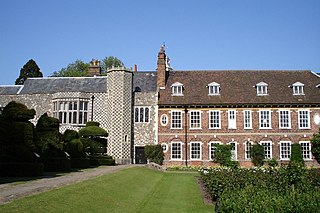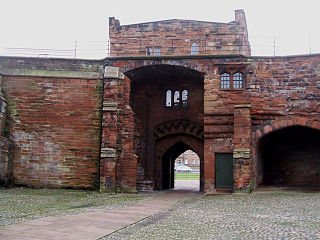Related Research Articles

There have been two Baronetcies created for persons with the surname Austen, one in the Baronetage of England and one in the Baronetage of Great Britain. Both creations are extinct.
Sir George Fletcher, 2nd Baronet was an English politician who sat in the House of Commons at various times between 1661 and 1700.
There have been three baronetcies created for members of the Mosley family, one in the Baronetage of England and two in the Baronetage of Great Britain. Only one creation is extant. Since 1980, the title has been held jointly with Baron Ravensdale in the Peerage of the United Kingdom.
The Kniveton Baronetcy, of Mercaston in the County of Derby, was a title in the Baronetage of England. It was created by King James I on 29 June 1611 for William Kniveton of Mercaston Hall, Muggington, Derbyshire. The family originated in the village of Kniveton,, from where their name derived. Branches of the family later had seats at Bradley and by virtue of the 15th century marriage of Nicholas Kniveton, at Mercaston, near Muggington, Derby
There have been four baronetcies created for persons with the surname Musgrave, one in the Baronetage of England, one in the Baronetage of Nova Scotia, one in the Baronetage of Ireland and one in the Baronetage of the United Kingdom. As of 2014 two of the creations are extant.
Peregrine Hoby, was an English landowner and member of parliament who sat in the House of Commons at various times between 1640 and 1679.
There have been three baronetcies created for persons with the surname Cooke, two in the Baronetage of England and one in the Baronetage of Ireland. One creation is extant as of 2013.

There have been six baronetcies created for members of the Corbet family, four in the Baronetage of England, one in the Baronetage of Great Britain and one in the Baronetage of the United Kingdom. All creations are extinct. The recipients were descendants of the ancient Norman family of Corbet which held substantial estates in Shropshire including Wattlesborough, Caus Castle, Moreton Corbet Castle and Acton Reynald Hall.

There have been three baronetcies created for descendants of the ancient Norman family of Molyneux who were granted extensive estates in Lancashire after the Norman Conquest.

There have been three baronetcies created for members of the Dixwell family, all of whom are descended from Charles Dixwell of Coton House, near Churchover, Warwickshire. All three baronetcies are extinct.

There have been five baronetcies created for members of the old established family of Peyton of Peyton Hall in the parish of Boxford in Suffolk, all of whom were descended from Sir Robert Peyton (d.1518) of Isleham in Cambridgeshire, grandson and heir of Thomas Peyton (1418–1484) of Isleham, twice Sheriff of Cambridgeshire and Huntingdonshire, in 1443 and 1453. All the baronetcies are extinct.

Two unrelated baronetcies have been created in the surname of Clifton.
There have been two baronetcies created in the Baronetage of England for members of the Culpeper family of Kent and Sussex. Both are extinct.

Sir Wilfrid Lawson, 1st Baronet, of Isel Hall, Cumberland (c. 1610–1688) was an English landowner and politician who sat in the House of Commons from 1660 to 1679.

Sir William Meredith, 3rd Baronet, was a British landowner who sat in the House of Commons from 1754 to 1780. A Rockingham Whig, he served as a Lord of the Admiralty from 1765 to 1766.
Sir William Dalston, 1st Baronet was an English politician who sat in the House of Commons from 1640 to 1644. He supported the Royalist side in the English Civil War.

Sir George Dalston (1581–1657) of Dalston Hall, Cumberland was an English politician who sat in the House of Commons of England between 1621 and 1643. He supported the Royalist cause in the English Civil War.

Sir Thomas Whitmore, 1st Baronet was an English politician who sat in the House of Commons of England between 1640 and 1644. He supported the Royalist side in the English Civil War.

The Abdy baronetcy, of Felix Hall, in the County of Essex, was created in the Baronetage of England on 14 July 1641 for Thomas Abdy who was High Sheriff of Essex. The title became extinct in 1868.
Sir George Dalston, 4th Baronet was a British baronet. He inherited the title from his father at a young age, and subsequently joined the Royal Navy, in which he served until 1742, reaching the rank of lieutenant. In 1754 he was elected to the parliamentary seat of Westmorland at the behest of his relations the Lowther family. Unaligned throughout his time in politics, Dalston retired in 1761 amidst increasing financial difficulties. He sold his seat of Dalston Hall soon afterwards, and died in relative poverty in 1765. Having only a daughter from his marriage, the baronetcy died with him.
References
- A Genealogical and Heraldic History of the Extinct and Dormant Baronetcies of England Ireland and Scotland Burke and Burke (1844) p 149 Google Books.
- Leigh Rayment's list of baronets